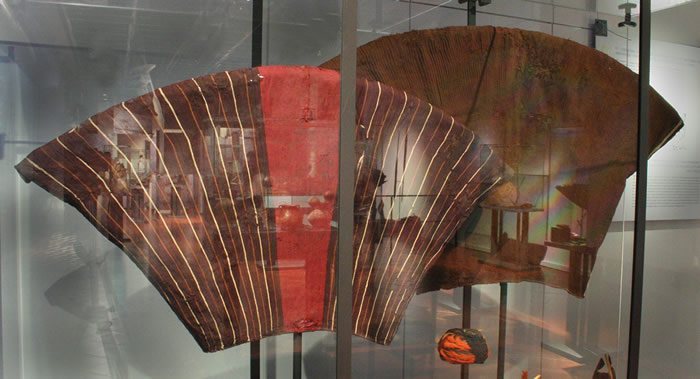
a) Bolsas listada y decorada. Fibra de camélido. Costa de Arica,Pescado res Tardíos , 1000 - 1350 d.C. Colección
Manuel Blanco Encalada,MCHAP Pe-133 y 119.
b) Túnica de niíio listada. Fibra de camélido. Costa de Arica,Pescadores Tardíos,1000 -1350 d.C. Colección Manuel
Blanco Encalada,MCHAP Pe-308.
c) Bolsa-faja listada. Fibra de camélido .Costa de Arica - Pescadores Tardíos (1000 -1350 d.C.). Colección Manuel Blanco Encalada,MCHAP Pe-146.

Vestimenta pescadora: Faldellín,sandalias,tocados de pluma,fajas ,collares y pulseras de cuentas de conc ha.
Colecciones Manuel Blanco Encalada-MC HAP ,Museo Regional de !quique,Museo de Tocopilla.

Vestimenta pescadora: Faldellín,sandalias,tocados de pluma,fajas ,collares y pulseras de cuentas de conc ha.
Colecciones Manuel Blanco Encalada-MC HAP ,Museo Regional de !quique,Museo de Tocopilla.

Camisas "unku" trapezoidales. Fibra de camélido. Costa de Arica,Pescadores Tardíos (1000-1350 d.C.). Colecció n
Manuel Blanco Encalada,MCHAP Pe-104 y 61.

Camisas "unku" trapezoidales. Fibra de camélido. Costa de Arica,Pescadores Tardíos (1000-1350 d.C.). Colecció n
Manuel Blanco Encalada,MCHAP Pe-104 y 61.

Pescadores Tempranos de Arica (dibujo,Alex Olave).

Faldellín de pabilos.Algodó n. Pescadores Tempranos , Tradición Chinchorro (6000-2500 a.C.). Colección
Museo Chileno de Arte Precolombino.

a) Casco de cuero de lobo marino pintado. Costa de lquique,Pescadores Tardíos (1000-1470 d.C.) .Colección
Museo Regional de !quique.
b) Gorro anillado con plumas. Fibra de camélido. Costa de Arica - Pescadores Tardíos (1000 -1350 d.C.).
Colección Manuel Blanco Encalada,MCHAP Pe-139.
c) Gorro de cuatro puntas anudado. Fibra de camélído..Costa de Arica - Pescadores Tardíos (1350 - 1470 d.C.).
Colección Manuel Blanco Encalada,MCHAP Pe-174.

a) Faldellín de fibra vegetal. Costa de lquique - Pescadores Temp ranos {Chinchorro). Colección Museo Regional de
lquique.
b) Colgante de conchas de ostión y collar de cuentas de concha. Costa de lquique - Pescadores Tempranos. Colección Museo Regional de lquique.
c) Tablilla porta plumas y colgante. Madera.Costa de Taltal - Pescadores Tardíos (1000 - 1470 d.C.). Colección
Museo Augusto Capdeville y Univesidad de Antofagasta .
d) Pendiente y cuchara-espátula .Cobre.Costa de Taltal - Pescadores Tardíos (1000 - 1470 d.C.). Colección Museo
Augusto Capdeville.

Túnica de niño listada. Fibra de camélido. Costa de Arica,Pescadores Tardíos,1000 -1350 d.C. Colección Manuel
Blanco Encalada,MCHAP Pe-308
The oldest known item of clothing from the coast is 9,000 years old and belonged to the Marine Gatherers. They used plant fibers and the skins of both land and sea animals to make their clothing and some of their hunting and fishing implements. Later, the Early Fishermen used clothing that included blankets and loincloths made from leather or camelid wool and plant fiber overskirts. Styles varied very little for thousands of years, being well suited to the coastal environment, the work these groups engaged in, and especially the availability of the raw material needed to make them. Over time, woven woolen tunics and wraps, cotton or wool yarn hank turbans, pelican feather headdresses and seashell and metal ornaments began to appear. The apparel of the Late Fishermen became more elaborate as the textile industry developed and these groups came into more frequent contact with inland farming and pastoral communities. From these people the fishermen obtained a greater quantity and more variety of camelid wool, new textile technologies, styles of dress and techniques for making them.













































